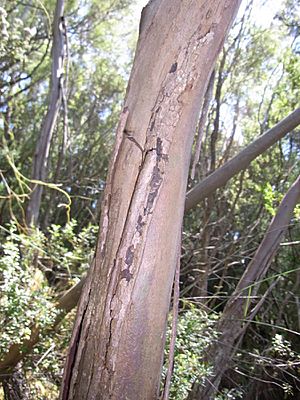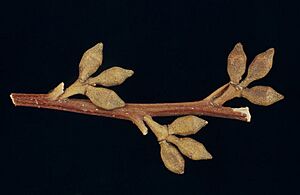Mount Imlay mallee facts for kids
Quick facts for kids Mount Imlay mallee |
|
|---|---|
 |
|
| Stem of Eucalyptus imlayensis in Mount Imlay | |
| Conservation status | |
| Scientific classification | |
| Genus: |
Eucalyptus
|
| Species: |
imlayensis
|
The Mount Imlay mallee (scientific name: Eucalyptus imlayensis) is a special type of small, bushy tree. It's a kind of mallee, which means it has many stems growing from the ground instead of just one main trunk. This unique plant is found only in one place in the world: near the top of Mount Imlay National Park in the far southeast of New South Wales, Australia. It has mostly smooth bark, long, thin leaves, white flowers, and interesting cup-shaped fruits.
Contents
What Does the Mount Imlay Mallee Look Like?
The Mount Imlay mallee usually grows up to about 7 meters (23 feet) tall. It has a special woody swelling at its base called a lignotuber. This helps the plant regrow if it gets damaged, for example, by fire. Its bark is smooth and peels off in ribbons. When the bark is new, it's green, but it changes to orange, brown, and then grey as it gets older.
Young plants have stems that are almost square with small "wings" on their corners. Their first leaves are usually opposite each other and are oval-shaped, about 4 to 7.5 centimeters (1.6 to 3 inches) long. The adult leaves are thicker and glossy green on both sides. They are shaped like a spear or are slightly curved, about 7.5 to 15 centimeters (3 to 6 inches) long.
The flowers grow in groups of three in the leaf corners. The flower buds are oval-shaped and about 5 to 6 millimeters (0.2 inches) long. When the flowers open, they are white. After flowering, the plant produces woody fruits. These fruits are shaped like a cup, bell, or half-sphere, about 4 to 5 millimeters (0.16 to 0.2 inches) long.
How Did It Get Its Name?
The Eucalyptus imlayensis was first officially described in 1980. Two scientists, Michael Crisp and Ian Brooker, wrote about it after finding a sample on Mount Imlay in 1978. The name imlayensis comes from Mount Imlay, which is where this plant was discovered.
Where Does It Live?
The Mount Imlay mallee grows in a special kind of mossy shrubland. This area is found on a very steep rocky slope made of quartzite rock. It is only known to live within the Mount Imlay National Park.
Other plants that grow nearby include tea tree, Imlay boronia, and devil's twine. The ground in this area is mostly covered with mosses. The soil is not very rich in nutrients and comes from sandstone and conglomerate rocks.
Why Is It Endangered?
The Eucalyptus imlayensis is a very rare plant. It is listed as "endangered" by the Australian Government and "critically endangered" by the New South Wales Government. This means it is at a very high risk of disappearing forever.
There are several reasons why this plant is in danger:
- Small Population: There are only about 80 mature trees left, and they all live in one small area.
- Insect Damage: Tiny insects called psyllids can damage the plants.
- No New Plants: Not enough new seedlings are growing to replace older trees.
- Diseases: A fungus called Phytophthora cinnamomi can cause the plants to die.
- Fires: Changes to the natural fire patterns in the area can also harm the plants.
Images for kids
-
Imlay Mallee with Devil's Twine








